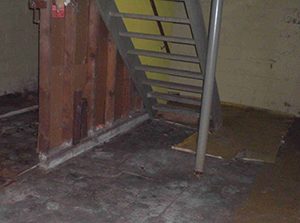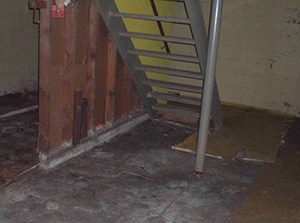If you’re like most homeowners, you probably don’t spend much time thinking about your unfinished basement. But when it’s time to clean those walls, it can be a daunting task. From dirt and dust to mold and mildew, unfinished basement walls can accumulate all sorts of grime over the years. In this article, we’ll share some tips and tricks for cleaning your unfinished basement walls and restoring your space to its former glory.
First, we’ll cover some basic cleaning techniques for removing dirt, dust, and debris from your walls. Then, we’ll discuss how to tackle the more challenging task of removing mold and mildew. Whether you’re preparing your basement for a remodel or just want to freshen up the space, these tips will help you get the job done quickly and efficiently. So, let’s get started!
- Remove any loose debris or cobwebs with a broom or vacuum.
- Mix a solution of warm water and mild detergent in a bucket.
- Using a stiff-bristled brush or sponge, scrub the walls with the solution.
- Rinse the walls with clean water using a hose or sprayer attachment.
- Dry the walls with a fan or dehumidifier to prevent mold growth.

How to Clean Unfinished Basement Walls?
Cleaning unfinished basement walls can be a daunting task, but it’s an essential part of maintaining a healthy home environment. Dust, debris, and even mold can accumulate on these walls, which can lead to health problems for you and your family. In this article, we will explore the best ways to clean unfinished basement walls and keep them looking their best for years to come.
1. Clear Out the Basement
Before you begin cleaning your unfinished basement walls, you need to make sure the area is clear of any clutter or debris. Move any boxes, furniture, or other items away from the walls so you can easily access them. This will also help to prevent any damage to your belongings while you clean.
Once the area is clear, you can begin to sweep or vacuum the floor to remove any loose dirt or debris. This will prevent any dust or dirt from settling on the walls during the cleaning process.
Benefits of Clearing Out the Basement:
– Prevents damage to your belongings
– Allows for easy access to the walls
– Prevents dust and dirt from settling on the walls during cleaning
2. Remove Cobwebs and Dust
The next step is to remove any cobwebs or dust from the walls. This can be done using a broom, vacuum, or duster. Start at the top of the wall and work your way down, making sure to get into all the corners and crevices.
If there are any stubborn spots, you can use a soft-bristled brush to gently scrub them away. For hard-to-reach areas, use a ladder or step stool to ensure you can clean every inch of the wall.
Benefits of Removing Cobwebs and Dust:
– Improves indoor air quality
– Helps prevent respiratory issues
– Makes the walls look cleaner and brighter
3. Address Any Mold or Mildew
If you notice any mold or mildew on your unfinished basement walls, it’s important to address it right away. Not only can it cause health problems, but it can also spread quickly if left untreated.
To remove mold or mildew from your walls, mix one part bleach with three parts water in a spray bottle. Spray the affected area and let it sit for 15-20 minutes before scrubbing it away with a soft-bristled brush. Be sure to wear gloves and a mask to protect yourself from the fumes.
Benefits of Addressing Mold or Mildew:
– Improves indoor air quality
– Prevents the spread of mold and mildew
– Helps prevent respiratory issues
4. Use a Cleaning Solution
Once you’ve removed any cobwebs, dust, and mold or mildew, it’s time to clean the walls with a solution. You can use a mixture of warm water and dish soap, or a specialized cleaner designed for unfinished basement walls.
Apply the solution to the wall using a sponge or soft-bristled brush, and work in small sections. Be sure to rinse the wall thoroughly with clean water to remove any soap residue.
Benefits of Using a Cleaning Solution:
– Removes stubborn stains and dirt
– Makes the walls look cleaner and brighter
– Helps prevent the growth of mold and mildew
5. Apply a Sealer
Once the walls are clean and dry, you may want to apply a sealer to help protect them from moisture and prevent the growth of mold and mildew. There are many different types of sealers available, so be sure to choose one that is specifically designed for unfinished basement walls.
Apply the sealer according to the manufacturer’s instructions, and be sure to allow it to dry completely before moving any furniture or boxes back into the area.
Benefits of Applying a Sealer:
– Helps prevent the growth of mold and mildew
– Protects the walls from moisture damage
– Extends the life of the walls
6. Clean Regularly
To keep your unfinished basement walls looking their best, it’s important to clean them regularly. This will help to prevent the buildup of dust, debris, and mold or mildew.
Depending on your needs, you may want to clean the walls once a month or more frequently. Be sure to follow the steps outlined in this article each time you clean to ensure the best results.
Benefits of Cleaning Regularly:
– Keeps the walls looking clean and bright
– Helps prevent the growth of mold and mildew
– Improves indoor air quality
7. Tips and Tricks
– Wear gloves and a mask to protect yourself from fumes and allergens.
– Use a ladder or step stool to reach high areas.
– Test any cleaning solution on a small, inconspicuous area before using it on the entire wall.
– Use a fan or dehumidifier to help dry the walls after cleaning.
Tips and Tricks Table:
| Tips and Tricks | Benefits |
|---|---|
| Wear gloves and a mask | Protects from fumes and allergens |
| Use a ladder or step stool | Ensures all areas are cleaned |
| Test cleaning solution first | Prevents damage to walls |
| Use a fan or dehumidifier | Helps dry the walls quickly |
8. Cleaning Unfinished Basement Walls vs. Finished Walls
Cleaning unfinished basement walls can be more challenging than cleaning finished walls, as there may be more dirt, dust, and debris to contend with. However, the steps outlined in this article can be applied to both types of walls.
One major difference is that you may need to apply a sealer to unfinished walls to protect them from moisture damage. Finished walls may already have a protective coating, so this step may not be necessary.
Benefits of Comparing Cleaning Unfinished Basement Walls vs. Finished Walls:
– Helps you choose the right cleaning method for your walls
– Saves time and effort
– Helps prevent damage to your walls
9. Benefits of Clean Unfinished Basement Walls
Keeping your unfinished basement walls clean has many benefits, including:
– Improving indoor air quality
– Preventing the growth of mold and mildew
– Making the walls look cleaner and brighter
– Protecting the walls from moisture damage
– Extending the life of the walls
Benefits Table:
| Benefits |
|---|
| Improves indoor air quality |
| Prevents the growth of mold and mildew |
| Makes the walls look cleaner and brighter |
| Protects the walls from moisture damage |
| Extends the life of the walls |
10. Conclusion
Cleaning unfinished basement walls may seem like a daunting task, but it’s an essential part of maintaining a healthy home environment. By following the steps outlined in this article, you can keep your walls looking their best and prevent the growth of mold and mildew.
Remember to clear out the area, remove cobwebs and dust, address any mold or mildew, use a cleaning solution, apply a sealer, and clean regularly. With these tips and tricks, you can keep your unfinished basement walls looking clean and bright for years to come.
Frequently Asked Questions
Here are some commonly asked questions about cleaning unfinished basement walls.
What tools do I need to clean unfinished basement walls?
To clean unfinished basement walls, you will need the following tools:
– A broom or vacuum to remove loose dirt and dust
– A bucket
– A scrub brush or sponge
– A cleaning solution, such as a mixture of water and vinegar or a commercial cleaner
Once you have gathered your tools, you can begin cleaning your unfinished basement walls.
Can I use bleach to clean my unfinished basement walls?
While bleach is a powerful cleaner, it is not recommended for use on unfinished basement walls. Bleach can be harmful to bare concrete or cinder block surfaces and may cause damage over time. Instead, use a cleaning solution that is specifically designed for unfinished basement walls, such as a mixture of water and vinegar or a commercial cleaner.
It is also important to wear protective gloves and goggles when using any cleaning solution to avoid skin and eye irritation.
How do I remove mold and mildew from my unfinished basement walls?
Mold and mildew can be a common problem in unfinished basements, especially in areas with high humidity or moisture. To remove mold and mildew from your walls, use a mixture of water and bleach or a commercial mold and mildew remover.
It is important to follow the instructions on the cleaner and wear protective gloves and goggles to avoid skin and eye irritation. After cleaning, allow the walls to dry completely and consider installing a dehumidifier to prevent future mold and mildew growth.
What should I do if I encounter large areas of peeling paint on my unfinished basement walls?
If you encounter large areas of peeling paint on your unfinished basement walls, it may be necessary to remove the paint before cleaning. Use a paint scraper or sandpaper to remove as much of the loose paint as possible, then clean the walls with a mixture of water and vinegar or a commercial cleaner.
If the peeling paint is extensive or the walls are in poor condition, you may need to consider repainting or applying a sealant to the walls to prevent further damage.
How often should I clean my unfinished basement walls?
The frequency of cleaning your unfinished basement walls will depend on the amount of dirt and dust that accumulates over time. As a general rule, it is recommended to clean your walls at least once per year or as needed if you notice significant dirt or mold buildup.
Regular cleaning and maintenance can help to prevent future damage to your walls and ensure that your basement remains a clean and safe environment.
UNFINISHED BASEMENT DEEP CLEAN WITH ME | LOTS OF DUST | TONS OF VACUUMING | CLEANING MOTIVATION
In conclusion, cleaning unfinished basement walls can be a daunting task, but it’s not impossible. With the right tools and techniques, you can make your walls look brand new again. Remember to start with a thorough inspection of the walls to identify any potential hazards. This will ensure your safety while cleaning.
Next, choose your cleaning solution carefully. There are many options available, but not all are suitable for unfinished walls. Avoid harsh chemicals that could damage the walls or harm your health. Instead, opt for a gentle yet effective solution that will remove dirt and grime without leaving any residue behind.
Finally, take your time and be thorough. Cleaning unfinished basement walls is not a job you want to rush. Take breaks as needed and don’t be afraid to ask for help if you need it. With patience and perseverance, you’ll soon have walls that look as good as new.

